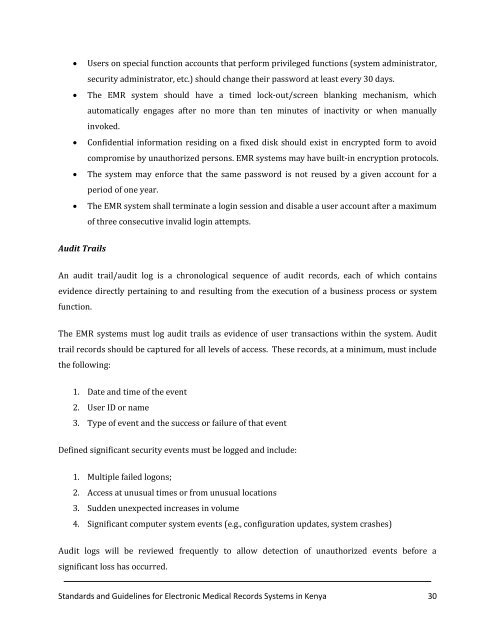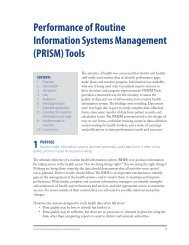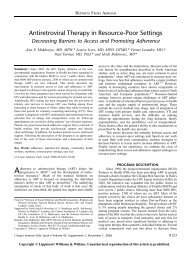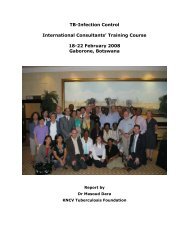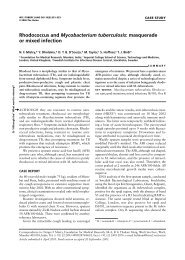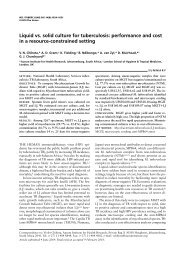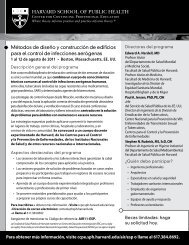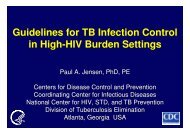Standards and Guidelines for Electronic Medical Record Systems in ...
Standards and Guidelines for Electronic Medical Record Systems in ...
Standards and Guidelines for Electronic Medical Record Systems in ...
You also want an ePaper? Increase the reach of your titles
YUMPU automatically turns print PDFs into web optimized ePapers that Google loves.
· Users on special function accounts that per<strong>for</strong>m privileged functions (system adm<strong>in</strong>istrator,<br />
security adm<strong>in</strong>istrator, etc.) should change their password at least every 30 days.<br />
· The EMR system should have a timed lock-out/screen blank<strong>in</strong>g mechanism, which<br />
automatically engages after no more than ten m<strong>in</strong>utes of <strong>in</strong>activity or when manually<br />
<strong>in</strong>voked.<br />
· Confidential <strong>in</strong><strong>for</strong>mation resid<strong>in</strong>g on a fixed disk should exist <strong>in</strong> encrypted <strong>for</strong>m to avoid<br />
compromise by unauthorized persons. EMR systems may have built-<strong>in</strong> encryption protocols.<br />
· The system may en<strong>for</strong>ce that the same password is not reused by a given account <strong>for</strong> a<br />
period of one year.<br />
· The EMR system shall term<strong>in</strong>ate a log<strong>in</strong> session <strong>and</strong> disable a user account after a maximum<br />
of three consecutive <strong>in</strong>valid log<strong>in</strong> attempts.<br />
Audit Trails<br />
An audit trail/audit log is a chronological sequence of audit records, each of which conta<strong>in</strong>s<br />
evidence directly perta<strong>in</strong><strong>in</strong>g to <strong>and</strong> result<strong>in</strong>g from the execution of a bus<strong>in</strong>ess process or system<br />
function.<br />
The EMR systems must log audit trails as evidence of user transactions with<strong>in</strong> the system. Audit<br />
trail records should be captured <strong>for</strong> all levels of access. These records, at a m<strong>in</strong>imum, must <strong>in</strong>clude<br />
the follow<strong>in</strong>g:<br />
1. Date <strong>and</strong> time of the event<br />
2. User ID or name<br />
3. Type of event <strong>and</strong> the success or failure of that event<br />
Def<strong>in</strong>ed significant security events must be logged <strong>and</strong> <strong>in</strong>clude:<br />
1. Multiple failed logons;<br />
2. Access at unusual times or from unusual locations<br />
3. Sudden unexpected <strong>in</strong>creases <strong>in</strong> volume<br />
4. Significant computer system events (e.g., configuration updates, system crashes)<br />
Audit logs will be reviewed frequently to allow detection of unauthorized events be<strong>for</strong>e a<br />
significant loss has occurred.<br />
<strong>St<strong>and</strong>ards</strong> <strong>and</strong> <strong>Guidel<strong>in</strong>es</strong> <strong>for</strong> <strong>Electronic</strong> <strong>Medical</strong> <strong>Record</strong>s <strong>Systems</strong> <strong>in</strong> Kenya 30


